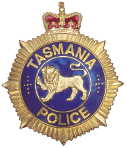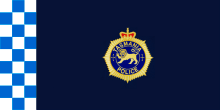Tasmania Police
| Tasmania Police | |
|---|---|
 | |
 | |
| Agency overview | |
| Formed | 1 January 1899 |
| Employees | 1,650[1] |
| Jurisdictional structure | |
| Operations jurisdiction | Tasmania, Australia |
| Size | 66,822 km2 (25,800 sq mi) |
| Population | 503,292 (as at 30 June 2010)[1] |
| Constituting instrument | |
| Headquarters |
47 Liverpool Street Hobart TAS 7000 42°52′48″S 147°19′40″E / 42.8800°S 147.3278°ECoordinates: 42°52′48″S 147°19′40″E / 42.8800°S 147.3278°E |
|
| |
| Sworn members | 1,260[1] |
| Minister responsible |
|
| Agency executive |
|
| Support Commands | Executive Support, Operations Support, Human Resources, Professional Standards, Special Response and Counter-Terrorism Unit |
| Districts | Southern, Northern, Western |
| Facilities | |
| Stations | 73 |
| Website | |
| www.police.tas.gov.au | |
| Data for organisation as at June 2011. | |
Tasmania Police is the police force of the Australian state of Tasmania. Established in 1899, the force has more than 1,200 officers policing Tasmania's population of about half a million people.
Structure
Tasmania Police is part of the Tasmanian government's Department of Police, Fire and Emergency Management, which also consists of the State Emergency Service, Forensic Science Service Tasmania and the Tasmania Fire Service.
State headquarters
The Commissioner of Police also serves as the secretary of the Department of Police, Fire and Emergency Management, and the State Emergency Management Controller.
Support commands
Tasmania Police comprises five support commands which support the geographical districts:
- Executive Support
- Operations Support – located in Hobart and manages the following functions:
- Cold Case Unit
- Firearms Services
- Forensic Procedures Compliance Unit
- Forensic Services
- Fraud & e-Crime Investigation Services
- Investigation Support Services
- Marine and Rescue Services
- Radio Dispatch Services
- State Community Policing Services
- State Intelligence Services
- Statewide Traffic Coordinator
- Human Resources
- Professional Standards (previously Internal Investigations)
- Special Response and Counter-Terrorism Unit (incorporating Specialist Capability Support including Dignitary Protection, Special Operations Group, Bomb Response Group, Hostage Negotiation, Police Technical Unit, Explosive Dog Detector Unit)
Geographical commands

The force is divided into three geographical district commands: Southern, Northern and Western. Each district is divided into several geographical divisions, and is administered by a Commander.
There are 73 police stations across the state.[2]
Tasmania Police Academy
The Tasmania Police Academy is located in the suburb of Rokeby on Hobart's Eastern Shore.
Local training of police officers in Tasmania began in 1958 at Sackville Street in Hobart. In 1960, Commissioner Delderfield suggested the establishment of a police training college on Hobart's eastern shore, and the idea was discussed until Commissioner Phil Fletcher managed to get the proposal approved by cabinet on 16 December 1969. Several sites were considered until Rokeby was selected.
The main road into the Tasmania Police Academy, Phil Fletcher Drive, was named in his honour.
The Academy was officially opened on 6 March 1976 by the Premier of Tasmania, Bill Neilson. Tasmania Police had the first purpose-built Police Academy in Australia.
The Tasmania Police Academy offers training for Tasmania Police recruits, currently serving Tasmania Police officers, and is offered as a community resource to various local community groups.
History
Prior to the formation of a unified police force, Tasmania (then called Van Diemen's Land) was policed from 1803 under the administration of Lieutenant Governor David Collins by a small number of superintendents and overseers, and from 1804 by a civilian body known as the "Night Watch", brought by Collins from Port Phillip Bay. The Night Watch was disbanded in 1806 due to ineffectiveness and was replaced by British military patrols. A municipal police force was established at Port Dalrymple (Launceston) on 19 November 1804, with Thomas Massey as Chief Constable.[3]
With the introduction of the Police Regulation Act 1898, one unified police force was established which came into being on 1 January 1899. George Richardson was appointed the first Commissioner of the new force, and he quickly implemented several structural changes to the existing municipal policing areas, amalgamating them into 14 districts between a total of 246 police members.[3] The early police officers were to undertake a wide variety of tasks from compiling the electoral roll in 1903, to tracking missing rifles from the Tasmanian contingent to the Second Boer War. Richardson complained frequently about the workload placed upon his officers, until a Royal Commission in 1905 recommended his replacement. William Hunt was appointed as Richardson's replacement but died before he could take office, and Colonel John Lord took his place, serving as Commissioner for 16 years with a break to serve with the First Australian Imperial Force during World War I.[3]
The Police Act 1905 defined and expanded the powers of Tasmania Police, which included liquor and lodging licensing, dog registration, vehicle regulation and disorderly conduct.[3] In October 1917, the force appointed its first female police officer, Kate Campbell, and in 1918 two women were added to police staff primarily to police child protection laws.[3] As of 30 June 2011, around 29 per cent of Tasmania Police officers were female.[1]
In 2004 the Police Regulation Act 1898 was finally repealed and the new Police Service Act 2003 (Tas) was proclaimed. The new Act retained a number of features of the old Act but the most controversial change was that of the powers of the Commissioner, including powers to test police officers for drugs and alcohol, integrity testing and the power to seek details of an officer's financial position.[4] The powers of the Commissioner may, generally speaking, only be used if there is some sort of suspicion attached to an individual police officer.
The Tasmanian Police Association was established in 1921, and in 1935 the Attorney-General wrote to the Commissioner stating that preference for transfers and promotion was to be given to members of the association. In addition to its social aspects, the Association also negotiated long-service leave arrangements for officers.[3]
Commissioners of Tasmania Police
The following police officers have been promoted in rank and appointed to serve as the Commissioner of Tasmania Police:
| Order | Commissioner | Term begin | Term end | Term in office | Comments, including reason for leaving office | Notes |
|---|---|---|---|---|---|---|
| 1 | George Richardson | 1 January 1899 | 1 January 1905 | 6 years, 0 days | Retired as Commissioner. | |
| 2 | Colonel John E C Lord CMG DSO VD | July 1906 | 10 February 1916 | 30 years, 336 days | Born 8 May 1870, acting commissioner from 1905–06. On 10 February 1916 granted leave of absence to serve with the 40th Tasmanian Battalion 1st AIF. Returned on 4 August 1919. Retired as Commissioner. | |
| 4 August 1919 | 24 November 1940 | |||||
| 3 | Walter Oakes MBE RVM | 25 November 1940 | 26 June 1944 | 3 years, 214 days | Born Tasmania 29 June 1878, joined Tasmania Police 7 May 1900. Resigned in 1913, served in Army, returned as a Detective Sergeant in 1918. Retired as Commissioner. | |
| 4 | Harry Hill | 27 June 1944 | 17 October 1949 | 5 years, 112 days | Born Tasmania 7 October 1884. Joined Tasmania Police 18 May 1907. Retired as Commissioner. | |
| 5 | Malcolm Dowling | 18 October 1949 | 31 December 1952 | 3 years, 74 days | Born Tasmania 19 June 1888, joined Tasmania Police 11 July 1910. Retired as Commissioner. | |
| 6 | William Delderfield MVO | 1 January 1953 | 25 September 1965 | 12 years, 267 days | Born UK 6 February 1901, joined South Australia Police 1 April 1922. Deputy Commissioner of Tasmania Police 1 December 1949. Retired as Commissioner. | |
| 7 | Philip Fletcher CBE MVO | 25 September 1965 | 8 July 1974 | 8 years, 286 days | Born Victoria 8 July 1914. Joined Tasmania Police 8 October 1935. Retired as Commissioner. | |
| 8 | Eric Knowles QPM | 9 July 1974 | January 1977 | 2 years, 206 days | Born 23 August 1914. Joined Tasmania Police 1940. Died in office as Commissioner. | |
| 9 | Max Robinson AO QPM | 7 May 1977 | 31 January 1988 | 10 years, 269 days | Born 21 February 1929. Joined NSW Police as cadet 1945, transferred to ACT Police 1948. Retired as Commissioner. | |
| 10 | William (Bill) Horman APM | 1 February 1988 | 30 March 1991 | 3 years, 57 days | Born 15 August 1939, joined Victoria Police 1956, Vanuatu Police in 1981, Deputy Director, Australian Bureau of Criminal Intelligence, 1983. Retired as Commissioner. | |
| 11 | John Johnson APM | 1 July 1991 | 12 July 1996 | 5 years, 11 days | Born 12 July 1936. Joined Victoria Police 10 May 1957, ACT Police 20 October 1958. Retired as Commissioner. | |
| 12 | Richard McCreadie AO APM | August 1996 | 7 March 2008 | 11 years, 219 days | Born 22 April 1946. Joined Tasmania Police 15 October 1964, Deputy Commissioner January 1991. Retired as Commissioner. | |
| 13 | Jack Johnston APM | 8 March 2008 | 14 August 2008 | 159 days | Joined Tasmania Police 9 February 1968, Deputy Commissioner 1996. Stood down and bailed to appear in the Supreme Court of Tasmania on 2 February over allegations he disclosed official secrets. His predecessor, Richard McCreadie, was appointed as Acting Commissioner in October 2008, however McCreadie's interim re-appointment was withdrawn after it was realised that the Police Service Act 2003 (Tas) states that in circumstances where the Commissioner is not available, that the Deputy Police Commissioner should take his place. | [5][6] |
| 14 | Darren Hine APM | 11 October 2010 | incumbent | 8 years, 4 days | Career with Tasmania Police; previously Deputy Commissioner; acting Commissioner between 2008 and 2010. | [7] |
Ranks
Tasmania Police has several ranks, some of which have various titles within that rank. Officers are promoted from one rank to another, however movement between designations within each rank is by completing parts of the promotion process, and comes automatically upon completing that part of the process. This promotion process has been in effect since 2003.
Ranks (and titles where applicable) are as follows:
Non-commissioned ranks
|
Commissioned officers
|
Equipment
_AT-X_-_Tasmania_Police_Vehicles.png)
Firearms
The general-issue Glock 17 9-mm semi-automatic pistol retains the "three-tier" safety features of the original model, and does not include any special features specific to Tasmania Police. Contrary to popular belief, there was never a Glock model specifically developed for use that was unique to Tasmania Police. Tasmania Police underwent a period of individual issue of the weapon until the adoption of the Glock 17 as the standard-issue weapon in 1999. The S&W Model 10 is no longer issued, or carried by Tasmania Police officers by the time of 2013.
The Glock 19 compact pistol was then generally issued mainly to traffic sections, and the Glock 26 sub-compact model was adopted as the general-issue sidearm for detectives and covert units. A degree of individual preference of model adopted by the individual officer exists to this day.
Operational equipment
In addition to firearms, police are also equipped with an expandable baton, OC spray. In April 2015, the Multiuse Integrated Protection Vest (MPIV) was issued, a combination of a load bearing vest and a Ballistic vest, with a high visibility over garment similar to vests in use with Victoria Police, together with a new uniform.[8][9]
Tasmania Police evaluated the use of taser stun guns in 2009, but the decision was made not to issue tasers to front-line officers. Currently, only officers of the Special Operations Group and the emergency response team at HM Prison Risdon are authorised to carry Tasers.[10]
In late 2017, it is expected the first trials of Body Worn Cameras will be rolled out to Frontline Officers.[11]
Vehicles
Tasmania Police vehicles are based around the Holden Commodore and Ford Falcon for general (urban) patrol. Various other makes and models are employed on a "best-suitability" basis for rural, investigative, personnel transport and general inquiry roles. The Ford Ranger and Toyota Hilux are currently used as base vehicles for divisional vans, fitted with a custom Vawdrey-brand rotary-moulded, "custody cell" for transport of prisoners. Divisional vans are also predominantly used as patrol-support vehicles, to transport people under-arrest who have displayed a propensity for violence.
Tasmania Police general patrol vehicles are equipped with mobile data terminals, used to interrogate criminal and traffic databases.[12]
Tasmania Police vehicles have a general exemption against the Tasmanian government's "green-fleet" designations, as most vehicles under this designation are unsuitable for policing duties, and do not comply with Australian standards for the minimum requirements for Australian police vehicles.
Tasmania Police currently employ the BMW R1200RT-P motorcycle to supplement traffic control and enforcement duties.[13]
Tasmania Police Pipe Band
The Tasmania Police Pipe Band was formed in 1969. The band wears the Fletcher of Dunans tartan in honour of the Commissioner of Police at the time Mr PW Fletcher CBE, MVO, JP.
See also
References
- 1 2 3 4 Annual Report 2010-2011 Archived 24 March 2012 at the Wayback Machine., Department of Police and Emergency Management, Government of Tasmania, October 2011.
- ↑ "Archived copy". Archived from the original on 7 November 2009. Retrieved 25 January 2010.
- 1 2 3 4 5 6 Easton, Geoff (1999). Tasmania Police from Force to Service 1803–1999. Hobart: Tasmanian Government.
- ↑ Police Service Act 2003, Tasmanian Consolidated Acts, 15 December 2003.
- ↑ "Police Commissioner Jack Johnston steps aside". The Examiner. 14 August 2008.
- ↑ "Former Tasmanian police commissioner to fill in for Jack Johnston". The Australian. 16 October 2008.
- ↑ Neales, Sue (6 November 2009). "McCreadie: 'I had a mandate'". The Mercury.
- ↑ Assistant Commissioner R Cowling (6 November 2014). "Multiuse Integrated Protection Vest (MIPV)" (PDF). Hellweg. The Police Gazette 22/2014. Retrieved 30 July 2016.
- ↑ "New Police Vests on the Beat". Tasmania Police (Press release). 17 April 2015. Retrieved 30 July 2016.
- ↑ Stedman, Michael (12 November 2009). "Taser rejection dismays police". The Mercury.
- ↑ "Body Worn Cameras". Tasmania Police (Press release). 16 May 2017. Retrieved 12 July 2017.
- ↑ "Radio Dispatch Services (RDS) Operations". Tasmania Police (Press release). 10 May 2012. Retrieved 11 July 2017.
- ↑ Luttrell, Alex (29 November 2016). "Six Tasmania Police officers vie for ticket as unrestricted motorcyclists". The Mercury. Retrieved 11 July 2017.
